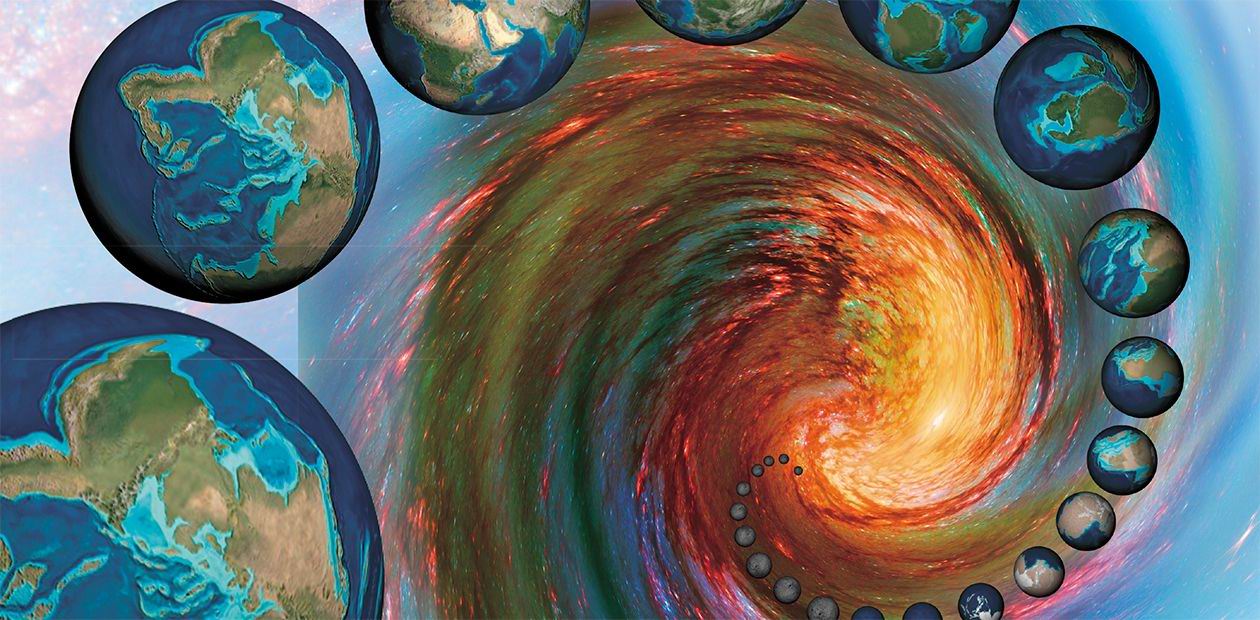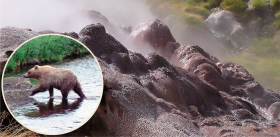Up the Evolutionary Scale. Evolution of the Earth, the Geographical Envelope, Climate, and the Biosphere
Our planet formed from a planetesimal descendant of the protoplanetary gas-and-dust cloud 4.5 billion years ago. In the course of evolution, the Earth cooled; the crust, oceans, and atmosphere formed; and convection patterns in the mantle varied. Landforms changed, and plate tectonics caused supercontinent assembly and dispersal. Current geological methods – chemical analysis and radiometric dating – allow better understanding of these processes. It has been found that the continuous exponential cooling of the globe drove a clearly periodic process: four (or more?) supercontinents that ever existed on the Earth arose at approximately equal time intervals
The development of our planet from a gas-and-dust cloud surrounding the Sun to its present state went through several important stages. The main forces affecting the transformation of the Earth’s exterior and interior are its constant cooling after the formation of 99.9% of its mass and stepwise oxidation of its surface and near-surface layers: the crust, hydrosphere, and atmosphere. This transformation can be assessed by comparing endogenous and subsurface processes and phenomena and by the analysis of geologic information, including the contents of various elements in the crust and core, radiometric analysis of rocks, and paleomagnetic data.
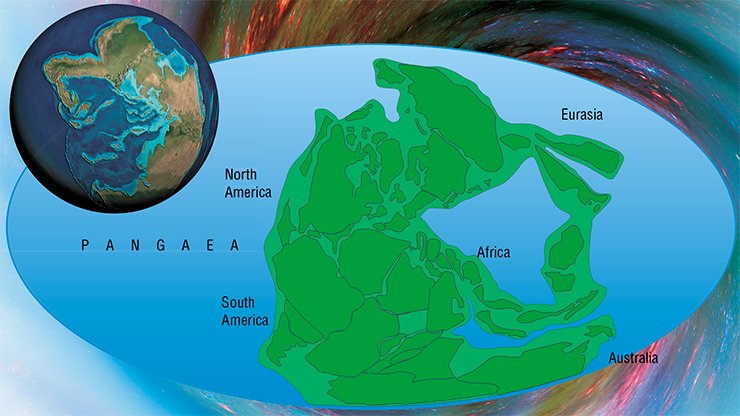
The reconstruction of our planet’s history will help us to understand its present state and forecast its further development. The significance of this knowledge for the humanity cannot be overestimated.
From Pangaea to Pangaea
Current astrophysical data indicate that the Earth was formed by hot accretion. The young planet was heated to high temperatures by impacts of protoplanetary bodies and decay of short-living isotopes. Then it cooled; the mean heat current and the mean mantle temperature decreased. At present, the temperature at the boundary between the upper and lower mantle layers is 2000—2100 °C, whereas at the end of the Archean–start of the Proterozoic (2.6—2.7 Ga BP) it was 2400 °C. Heat was dissipated by emission to the space, and the reserve of thermal energy in the Earth’s interior decreased.
The intensity of convection in the lower mantle can be assessed from data on the temperature and the heat current from the mantle. Presently, it is thought that the variation in the heat current with the Earth’s cooling, even at a practically constant temperature gradient between the upper and lower mantles can result in significant, by two or three orders of magnitude, changes of magma viscosity and the Rayleigh number, which characterizes convection. In the Archean, convection in the lower mantle was much more intense, approaching the rate in the present-day asthenosphere, owing to high heat current values. Therefore, ascending flows could involve the entire mantle to cause general mantle convection and small plate tectonics.
THE NASCENCE OF PLANETSThe changes in convection regimes and, correspondingly, in plate tectonics resulted in supercontinent assembly and dispersal. This process was cyclic. The largest, 600—700 Ma, cycle can be established from intervals between Pangaeas and maximal isotopic ages of rocks. The existence of Permian Pangaea IV has been reliably proven. Its assemblage reached its maximum in the late Devonian and early Carboniferous, 360 Ma BP. The disintegration of Pangaea IV started in the Triassic, about 230 Ma BP. Supercontinent III, Rodinia, existed within 1100—920 Ma BP. The immediately earlier supercontinent II, Columbia, or Nuna, existed from 1800 till 1650 Ma BP. The existence of Supercontinent I is cast doubt upon, and the interval between clear maximums at 2680 and 1880 Ma BP is 800 Ma. Thus, the estimates vary from 690 (645) to 800 Ma, and we can tentatively take the time interval from Pangaea to Pangaea to be 700 Ma.
The continuous cooling of the Earth altered convection regimes in the mantle. Surprisingly, the nearly exponential decrease of heat current from the interior resulted in a clearly pronounced cyclic formation of supercontinents; hence, convection variation was also cyclic.
At first, the Earth had no moon...
The planet Earth started its life 4.55—4.44 Ga BP. The duration of its initial growth and iron core formation was determined by mantle dynamic viscosity, which may have varied during the accretion by two or three orders of magnitude. Therefore, estimates of the duration of this stage also differ by two orders: from 10,000,000 to 1,000,000,000 years. The timing is refined by the measurement of hafnium and tungsten contents in terrestrial and lunar rocks. It indicates that the Earth’s core formed nearly simultaneously with the globe growth: in the first 30—50 Ma of its existence.
The Earth history after the accretion depends profoundly on the way the Moon formed. According to the megaimpact hypothesis, the Moon was formed by a collision between the Earth and a hypothetical Mars-sized planet about 4.48 Ga BP. By that time, the Earth’s formation had been nearly completed. Its upper layer was a 600—1000 km deep magma ocean with a thin basalt crust no thicker than 10 km, which was constantly broken by meteorites. As a result of the collision, parts of the Earth’s crust and mantle and of the colliding body were thrown into a circumterrestrial orbit and ultimately formed the Moon. However, some scientists indicate that the megaimpact hypothesis is hardly likely, because such a powerful shot would have produced an eccentricity of the Earth’s orbit about ten times as large as the present one.

Another hypothesis indicates that the Moon may have been formed by a series of minor impacts of bodies comparable with itself in size. In this model, the Earth could have a shallower magma ocean (< 300 km). However, in this case, as in the case of a single impact, it is difficult to explain the preservation of the thrown matter in the circumterrestrial orbit and its secondary accretion into the Moon.
Finally, the hypothesis of simultaneous formation of the Earth and Moon as a double planet has reasonable geochemical and cosmochemical substantiation.
All the three hypotheses differ in the degree of perturbations they could have caused in the Earth’s state. The megaimpact could produce the greatest effect on the mantle composition and result in a high degree of differentiation in the interior structure of the Earth and its temperature. In contrast, the hypothesis of simultaneous formation of the Earth and Moon assumes undisturbed internal evolution of both celestial bodies.
HAFNIUM AND TUNGSTEN: TIMESTAMPSDuring the separation of iron from rocks constituting the Earth, the bulk of siderophilic tungsten passed into the core, whereas the totality of lithophilic hafnium remained in the silicate layer. Therefore, the 182W : 184W ratio in this layer is expected to be larger than in the parental mixture because of the radioactive decay of hafnium. It depends on the residual undecayed amount of this element by the time of tungsten passing from the rock to the core. By measuring the proportions of tungsten isotopes in the crust and comparing them with their contents in chondrites, bodies formed in the protoplanetary disk before Earth formation, one can evaluate the age difference between chondrites and ancient rocks, thereby dating the core formation (Wood, 2011).
By the end of the accretion stage, a hot atmosphere had been produced mainly by falling comets. It was dominated by hydrogen and methane. In terms of water, it might have constituted two to ten weights of the present-day hydrosphere. However, by 4.4 Ga BP, the early atmosphere had been lost owing to intense hydrogen escape to the space. At that time, the oxidation of the atmosphere, Earth surface, and then the crust and the upper mantle started and continued at later developmental stages.
Hadean: young Earth and lifeless oceans
The timespan since the termination of accretion (4.44 Ga BP) till 3.9 Ga BP is named the Hadean, or the Pregeologic Eon, because there is virtually no geologic record of that time. In the Hadean, the planet was cooling most rapidly; the magma ocean, whose volume had been close to that of the upper mantle, disappeared; and the mantle was separated into the upper and the lower. The crust, including that of the continental type, began to form, and the World Ocean arose on the surface. The existence of continental crust and the ocean is evidenced by zircons dated to 4.0—4.2 Ga and rounded, apparently, by liquid water. Occasional 4.4 Ga old zircons are found in younger sedimentary rocks. In some cases, these zircons contain diamond microinclusions, where the microstructure and the distribution of thorium and vanadium are similar to those found in impact diamonds on the Moon. This observation indicates that they resulted from heavy bombardment of the Earth’s surface by large meteorites.
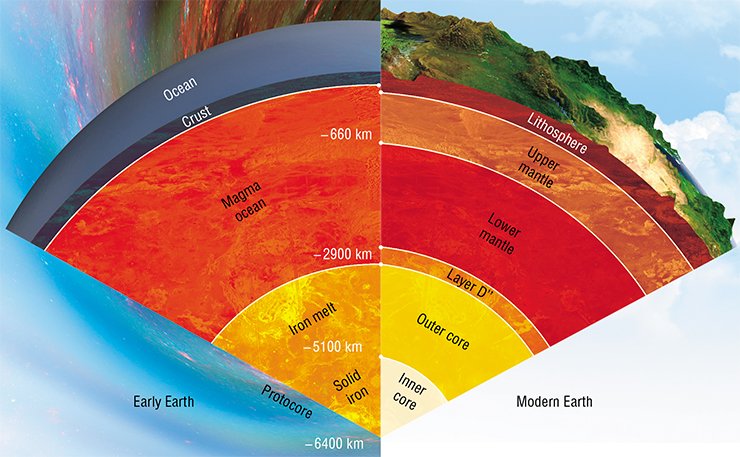
As noted above, the lifetime and depth of the magma ocean depend on the Moon’s genesis and the intensity of meteoritic bombardment. The estimates are broadly variable, but it is hardly likely that the magma ocean existed after 4.0 Ga BP. Nevertheless, Shkodzinskii (2009) believes that magma ocean formation was the most important event in the Earth’s history and admits that remains of that ocean survived for a good while (Shkodzinskii, this issue, p. 42).
The diamond milestone
The mantle and core cooled further in the Archean, 3.9 to 2.7 Ga BP. As a result, the Earth acquired its inner core, and the magnetic field increased by a factor of 1.5—2. Large-scale formation of diamonds was a trace of the cooling of upper layers. About 90% of ancient diamonds brought to the surface with kimberlites are dated to 3.2—2.9 Ga. This fact is related, first, to lithosphere thickening and the resulting increase in the pressure produced in the solid interior by rock weight. In the middle of the Archean, the lithosphere thickness (crust plus solid mantle) exceeded 100 km. Earlier, it was 50 km or less. The modern oceanic lithosphere is about the same thickness. Second, the mantle was notably oxidized, giving rise to carbonatites and solutions enriched in carbon dioxide. They reacted with methane to yield carbon, from which diamonds were later formed. Thus, the diamond milestone is an important sign of the change in the heat regime and mantle oxidation state.
In total, 20 to 50% of the continental crust volume had formed by the end of the Archean.
From small plate tectonics to plume tectonics and supercontinents
The Archean/Proterozoic boundary (2.6—2.7 Ga BP) corresponds to one of the major maximums of the formation of crust-forming granites and alkaline rocks. It is likely that the first supercontinent formed at the same time, but we lack geological and paleomagnetic information to delineate it and even to prove its existence. Before that time, mantle convection was close to turbulent, and small plate tectonics was predominant. Some scientists think that convection in the mantle was bilayered throughout the Archean, whereas others insist that it could have been chaotic (highly turbulent) but involved the entire mantle.
Anyway, mantle convection changed its mode at that milestone, which resulted in the consequences mentioned above and some others, also of great significance.
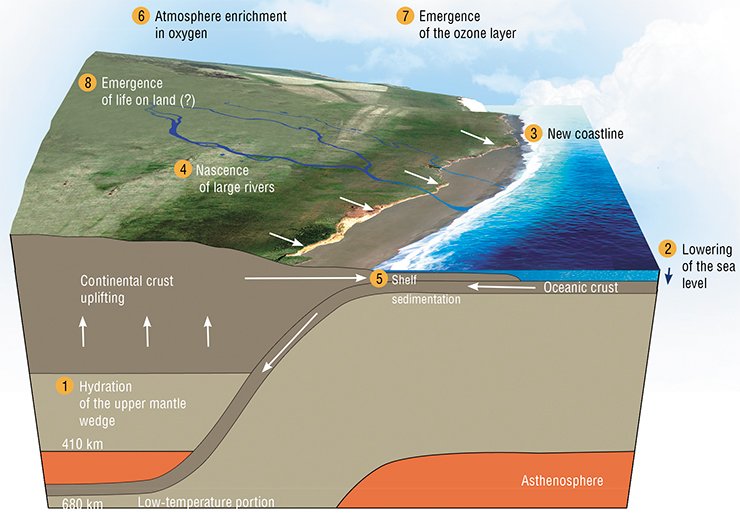
The change brought into existence superplumes (ascending jets in the mantle), and plume tectonics started. This event corresponds to the first maximum of mantle rock ages. Probably, the bilayered convection in the upper and lower mantle, if it existed before the event, was preserved, but it was disturbed by large jets of ascending superplumes and large drops of melting crust from subduction zones, which submerged to the core. According to geochemical evidence, the magma reservoirs of the lower and upper mantle differentiated again by 2.0—1.8 Ga BP.
In the Paleoproterozoic, 2.6—2.8 Ga BP, the bulk of the continental crust formed. Late in that phase, within 1.9—1.7 Ga BP, there were large collisions of tectonic plates, and the second greatest granite formation maximum occurred. The supercontinent named Columbia, or Nuna, formed at the same time.
In the next time span, from 1.7 till 0.7 Ga BP, the internal activity of the Earth was low. Mantle currents were rearranged. The whole-mantle convection regime gave way to the bilayered one, and plume activity decreased. This time was marked by the aggregation and dispersal of the third supercontinent, Rodinia (from the Russian word rodit’, “to give birth”).
The “dead Earth” gave birth to life
The time about 750 Ma BP deserves special attention. All accessible rocks dated to before 1 Ga bear traces of their formation under relatively low pressures. Such pressures can exist in the depth range about 40—60 km. The age 750 Ma corresponds to rocks that demand higher pressure for their formation. This fact is indicative of their formation at larger depths, 150—200 km, or, which is the same, of lower temperatures in the same depth range. For example, the temperature at 100 km might decrease from 1000 to 400—600 °C.
This decrease could occur only if the velocity of subduction (submergence of the crust into the mantle) notably increased and reached (or even surpassed) the present maximum subduction velocity, about 10 cm/year.
The subduction acceleration allowed hydrous minerals to be dragged to the mantle in subduction zones. As a result, the upper mantle wedge beneath a continent was hydrated and swelled. Continents rose, and the sea level subsided. The increase in level differences between continents and seas produced systems of large rivers. Rocks carried out by the rivers extended the shelves, and sedimentation on shelves increased. So did photosynthesis rate and hydrocarbon concentrations.
Photosynthesis increased oxygen content in the atmosphere. This resulted in the emergence of the ozone screen, which allowed life to conquer the land.
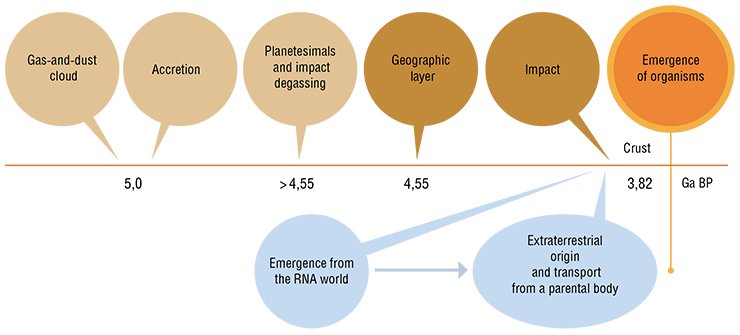
These events were preceded by a decrease in the inner activity of the Earth. Some scientists (Sh. Maruyama et al.) refer to this interval as the Dead Earth. Its features are explained by a rearrangement of convective flows and plumes in the mantle. The rearrangement resulted in the cooling of the Earth surface, and the time span from 700 to 600 Ma BP witnessed frequent and large-scale glaciations. One of them, possibly, the greatest, happened about 640 Ma BP. The frozen Earth of that time is described as the “snowball Earth”. This state was first conjectured on the base of geochemical data and paleomagnetic measurements in glacial deposits, which were often detected nearby the ancient equator. This theory suffers from some ambiguities and contradictions; therefore, this putative scenario of global glaciations is but one of many.
The subduction intensification within 750—600 Ma BP generated an outbreak of island-arc magmatism. It was accompanied by tremendous eruptions, large-scale but variable release of carbon dioxide to the atmosphere, further atmosphere oxidation, and climate warming. Starting from 600 Ma, endogenous systems, the climate, and the biosphere have developed the ways close to the modern ones.
Thus, the continuous cooling and oxidation of the Earth caused a variety of processes. Convection regimes in the mantle varied and resulted in supercontinent formation and fragmentation. The lithosphere and crust became thicker, the surface cooled, seas arose and, correspondingly, sedimentary rocks began to form. The crystallized crust submerged to the mantle in subduction zones, upheaving the above continents. Geologic processes on the globe gradually became quieter, the mean surface temperature decreased, and conditions favorable for existence and evolution of living organisms emerged.
Although the Earth’s cooling obeyed the exponential law, it was influenced by periodical tectonic and geologic processes. The chemical composition and age of rocks, their formation depth and temperature, lifetime of supercontinents, sedimentation rate, and some other parameters demonstrate certain relationships. Thus, processes occurring on the Earth are interrelated. Geologic changes on the surface are governed by interacting internal and external factors, such as convection rate in the mantle, solar activity, etc. This points to the integrity of processes occurring on the Earth, which is a single whole organism, where various aspects of its life are orchestrated.
References
Dobrecov N. L. Osnovy tektoniki i geodinamiki / uchebnoe posobie / Novosibirsk: NGU, 2011.
Wood B. The formation and differentiation of Earth // Physics Today. December 2011. P. 40–45.
![Dobretsov N.L. Fundamentals of tectonics and geodynamics: A textbook. Novosibirsk: Novosibirsk State University, 2011. 492 p. [in Russian] ISBN 978-5-94356-990-6 Dobretsov N.L. Fundamentals of tectonics and geodynamics: A textbook. Novosibirsk: Novosibirsk State University, 2011. 492 p. [in Russian] ISBN 978-5-94356-990-6](/files/medialibrary/05f/05fbe2665daef1937a47fd8bd41036fa.jpg) The treatise by Nikolai Leontievich Dobretsov Fundamentals of tectonics and geodynamics has been designed as a textbook for students and bachelors of geology and a supplement to the course of lectures delivered by N. Dobretsov to students of the Department of Geology and Geophysics, Novosibirsk State University. It considers comprehensively a broad range of problems, being valuable not only for students and postgraduates in geology but also for experts in other fields of knowledge associated with the evolution of our globe.
The treatise by Nikolai Leontievich Dobretsov Fundamentals of tectonics and geodynamics has been designed as a textbook for students and bachelors of geology and a supplement to the course of lectures delivered by N. Dobretsov to students of the Department of Geology and Geophysics, Novosibirsk State University. It considers comprehensively a broad range of problems, being valuable not only for students and postgraduates in geology but also for experts in other fields of knowledge associated with the evolution of our globe.
This book is the first attempt to demonstrate cause-and-effect relationships of the deep structure, composition, and interaction of all layers of the Earth as the main cause of tectonic movements in the Earth’s crust and the upper mantle (tectosphere). Current knowledge of major tectonic elements building the oceanic bottom, island arcs, cratons, and folded belts is presented. In contrast to common tutorials on tectonics and geodynamics, much attention is drawn to model analysis, which adds to the understanding of the factors that governed the formation of large bodies of the Earth. In particular, modeling of convection in the upper mantle demonstrates the inevitability of formation of transform faults in mid-ocean ridges. Model analysis of subduction zones illustrates the causes of the appearance of high-pressure metamorphic assemblages on the surface, including diamondiferous metamorphic rocks detected in the Kokshetau metamorphic belt, Northern Kazakhstan. By invoking modern seismic tomography data, a thermophysical model of melting in the subduction zone is constructed. It contributes to understanding the features of island-arc magmatism evolution and seismicity in these tectonically active regions of the Earth.
At present, a new direction in geology is being extensively developed: deep-level geodynamics. It considers the nature of global processes with regard to the interaction of the Earth levels of various depths, down to the core. It has been shown that plumes, hot fields, and superplumes are involved in various tectonic processes (Zonenshain, Kuzmin, 1983; Hoffman, 1997; Flower, 2000; Kuzmin et al., 2001; Yarmolyuk et al., 2002; Dobretsov, 2003). The complicated interaction of mantle magmatism with the crust and lithospheric mantle generates bimodal volcanic rocks, gabbro–granite series, and traps. There are few, if any, manuals on this problem, whereas foreign scientists pay much attention to large igneous provinces and their metallogeny (Abbott et al., 2002; Ernst et al., 2004). The book under discussion places high emphasis on this subdiscipline. It presents not only factual data but also calculations of the thermochemical model of plumes varying in size, which are separated from the core–mantle boundary (layer D’’), and their interaction with various Earth layers. An individual section is dedicated to the evolution of the biosphere as one of Earth layers. This section is of special interest for paleontologists and biologists.
Head of the Laboratory of Petrology and the Ore Potential of Igneous Provinces,
Sobolev Institute of Geology and Mineralogy, Siberian Branch of the RAS


